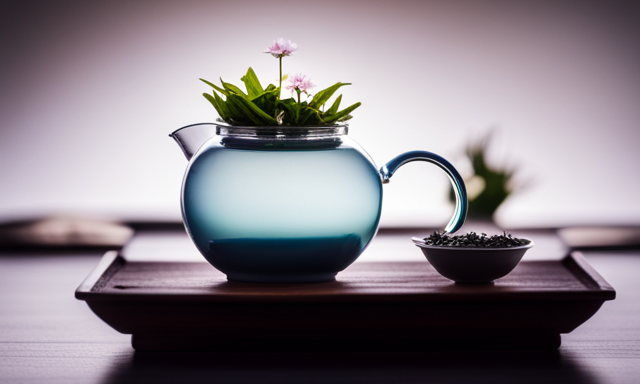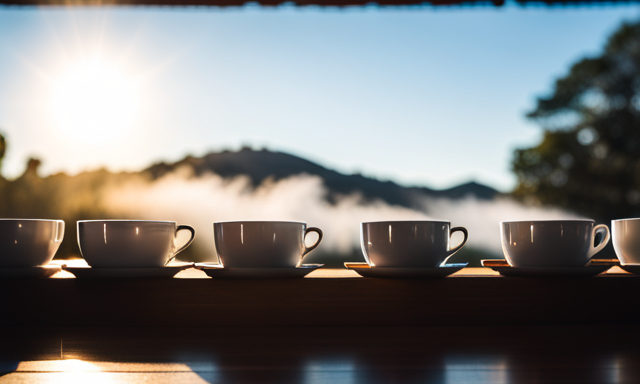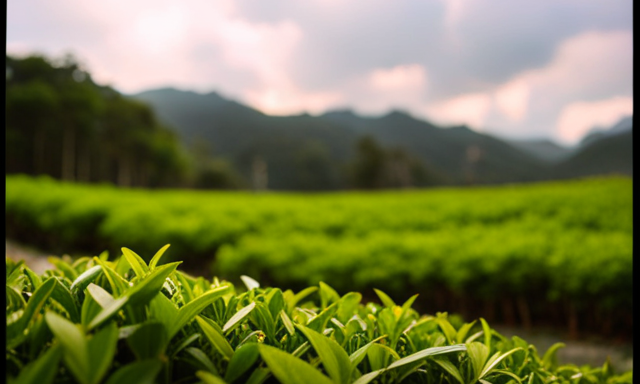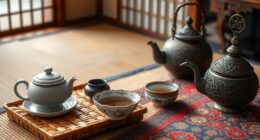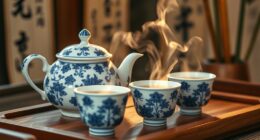As a tea lover, I’m constantly on the lookout for new blends and flavors to enhance my daily routine. Recently, I found myself pondering a question that had me intrigued: Which tea, English Breakfast or Oolong, contains more caffeine?
The world of tea is vast and diverse, and each variety offers its own unique characteristics. Both English Breakfast and Oolong tea have their loyal fan bases, but when it comes to caffeine content, does one reign supreme over the other?
In this article, we will delve into the origins and history of these two teas, explore the caffeine content in each, and discuss the effects of caffeine on the body. By the end, we hope to shed light on this caffeine conundrum and help you make an informed decision about which tea suits your personal preferences and taste profiles.
So, grab your favorite mug and let’s embark on this tea-filled journey together.
Key Takeaways
- Caffeine is a natural stimulant found in both English breakfast and oolong tea.
- English breakfast tea generally contains higher levels of caffeine compared to oolong tea.
- Factors such as tea leaves and brewing time can influence the caffeine content in both types of tea.
- Personal preferences and health considerations should be taken into account when choosing between English breakfast and oolong tea.
The Origins and History of English Breakfast Tea
As you sip your morning cup of English breakfast tea, envision the rich history and origins behind this beloved blend. Understanding the cultural significance of English breakfast tea takes us back to the 19th century when it was first created in Scotland.
Contrary to popular belief, this tea does not originate from England, but its name is a nod to the fact that it became immensely popular in England.
English breakfast tea is a blend of black teas, typically Assam, Ceylon, and Kenyan teas, known for their robust flavors and dark liquor. It is often enjoyed with milk and sugar, providing a hearty and comforting start to the day.
Exploring the different flavor profiles of oolong tea, we transition into the origins and history of this unique tea variety.
The Origins and History of Oolong Tea
To truly grasp the rich history of Oolong tea, imagine yourself transported back in time to the origins of this fascinating beverage. Oolong tea is a traditional Chinese tea that has been enjoyed for centuries. It is known for its unique combination of the qualities of both green and black teas.
Oolong tea offers a wide range of health benefits, including improved digestion, weight management, and reduced risk of heart disease. The production process of Oolong tea involves withering the leaves under the sun, then gently bruising and oxidizing them before they are dried. This careful process creates a tea with a distinct flavor and aroma.
Now that we have explored the origins and history of Oolong tea, let’s delve into understanding the caffeine content in tea.
Understanding Caffeine Content in Tea
Understanding the caffeine content in tea is important because it can vary depending on the type and brewing method. Everyone’s caffeine metabolism is different, with some people being fast metabolizers and others being slow metabolizers. This can affect how sensitive you are to the effects of caffeine. Oolong tea generally contains less caffeine than black tea, but it can still provide a moderate energy boost. Now, let’s shift our focus to the caffeine content in English breakfast tea, which is known for its robust flavor and invigorating qualities.
Caffeine Content in English Breakfast Tea
Brewed to perfection, a cup of English Breakfast tea offers a delightful pick-me-up with its invigorating qualities. When it comes to caffeine content, English Breakfast tea typically contains a moderate amount compared to other teas.
Here are four key points to consider in the English breakfast tea vs oolong tea caffeine comparison:
-
English Breakfast tea is a black tea blend that is known for its robust flavor and higher caffeine content compared to other black teas.
-
On average, an 8-ounce cup of English Breakfast tea contains around 40-70 milligrams of caffeine, depending on the brewing time and strength.
-
Caffeine stimulates the central nervous system, enhancing alertness and reducing fatigue.
-
Moderate caffeine consumption can improve focus, mood, and physical performance.
As we explore the caffeine content in oolong tea, we will discover its unique qualities and how it compares to English Breakfast tea.
Caffeine Content in Oolong Tea
Compared to other teas, oolong tea packs a unique punch with its caffeine content. This partially fermented tea falls between green and black tea in terms of oxidation, making it a popular choice for those seeking a moderate caffeine boost. Oolong tea typically contains around 30-50 milligrams of caffeine per 8-ounce cup, although this can vary depending on the specific variety and brewing method.
To better understand the caffeine content in oolong tea, let’s compare it to other common beverages. Here’s a table showcasing the caffeine content of popular drinks:
| Beverage | Caffeine Content (mg) |
|---|---|
| Oolong Tea | 30-50 |
| Green Tea | 20-45 |
| Black Tea | 40-70 |
| Coffee | 95-200 |
While oolong tea may not have the highest caffeine content, it still provides a gentle energy boost without the jitters often associated with coffee. Additionally, oolong tea offers a range of health benefits such as improved digestion, enhanced metabolism, and potential antioxidant effects.
Moving on to comparing the caffeine levels in English breakfast and oolong tea…
Comparing the Caffeine Levels in English Breakfast and Oolong Tea
When comparing the caffeine levels in English Breakfast and Oolong Tea, one important question arises: which tea has more caffeine?
This is a crucial factor to consider for those seeking a high-caffeine tea option. However, it’s essential to take into account other factors as well, such as brewing methods and steeping time, as these can impact the final caffeine content in a cup of tea.
Which Tea Has More Caffeine?
Oolong tea packs more caffeine than English breakfast tea. When it comes to choosing a tea with a higher caffeine content, oolong tea is the winner. Here are three reasons why:
-
Oolong tea is known to have a higher caffeine content compared to English breakfast tea. It contains approximately 37 mg of caffeine per 8-ounce cup, while English breakfast tea contains around 29 mg. This difference may seem small, but it can make a significant impact on your daily caffeine intake.
-
Caffeine has a stimulating effect on the central nervous system, which can help increase alertness and focus. However, it’s important to note that consuming caffeine, especially in high amounts, can interfere with sleep patterns. So, if you’re sensitive to caffeine or have trouble sleeping, it’s essential to limit your intake, especially in the evening.
-
While oolong tea has more caffeine than English breakfast tea, it still contains less caffeine than coffee. So, if you’re looking for a tea with a moderate caffeine boost, oolong tea can be a great choice.
Considering the caffeine content is just one factor to consider when choosing a high-caffeine tea.
Factors to Consider When Choosing a High-Caffeine Tea
When considering which tea has more caffeine, it’s important to take into account various factors.
One of the key factors to consider is personal preference. Some people may prefer the robust and bold flavor of English breakfast tea, while others may enjoy the delicate and floral notes of oolong tea.
Another factor to consider is the brewing method and steeping time. The longer you steep the tea, the higher the caffeine content is likely to be.
Additionally, the quality of the tea leaves can also impact the caffeine levels. Higher quality leaves often contain more caffeine.
Ultimately, the decision between English breakfast tea and oolong tea comes down to individual taste preferences and the desired caffeine intake.
Now, let’s delve into the effects of caffeine on the body.
The Effects of Caffeine on the Body
When it comes to the effects of caffeine on the body, there are several key points to consider.
Firstly, caffeine is known for its stimulant properties, which can increase alertness and improve concentration.
Additionally, there are several potential health benefits associated with moderate caffeine consumption, such as a reduced risk of certain diseases.
However, it is important to also be aware of the potential risks, including increased heart rate and blood pressure, as well as potential sleep disturbances.
Stimulant Properties
English breakfast tea, with its rich and robust flavor, is known for its invigorating and stimulating properties. One of the primary reasons for this is its caffeine content. Caffeine is a natural stimulant that affects the central nervous system, promoting wakefulness and alertness.
When consumed, caffeine blocks the neurotransmitter adenosine, which is responsible for promoting sleep. As a result, it can have a negative impact on sleep quality, making it harder to fall asleep and stay asleep.
Additionally, excessive consumption of caffeine can lead to potential side effects such as increased heart rate, anxiety, and digestive issues. However, it’s important to note that the effects of caffeine can vary from person to person, and some individuals may be more sensitive to its stimulating properties than others.
Moving on to the subsequent section about health benefits and risks, it is crucial to consider both the positive and negative aspects of consuming English breakfast tea.
Health Benefits and Risks
To fully understand the health benefits and risks of oolong tea, it’s important for you to consider the potential effects it may have on your overall well-being. While oolong tea is generally considered safe for consumption, there are some health risks associated with excessive intake or certain medical conditions.
Here are three important factors to keep in mind:
-
Caffeine sensitivity: Oolong tea contains caffeine, which can cause increased heart rate, anxiety, and sleep disturbances in individuals who are sensitive to it.
-
Bone health: Some studies suggest that long-term consumption of oolong tea may contribute to bone loss due to its potential interference with calcium absorption.
-
Blood sugar control: Oolong tea has been shown to help regulate blood sugar levels, which can be beneficial for individuals with diabetes. However, it’s essential to monitor blood sugar levels closely and consult with a healthcare professional.
Understanding the potential health risks and benefits of oolong tea is crucial for making informed choices about your well-being.
Moving forward, let’s dive into personal preferences and taste profiles.
Personal Preferences and Taste Profiles
If you’re into different taste profiles, oolong tea might be more your style. Oolong tea offers a wide range of flavor profiles, from floral and fruity to woody and nutty. Its unique taste is a result of its partial oxidation process, which falls between green and black tea. To give you a better idea of the diverse flavors of oolong tea, here is a table showcasing some popular varieties:
| Variety | Flavor Profile |
|---|---|
| Tie Guan Yin | Floral, creamy |
| Da Hong Pao | Roasted, earthy |
| Oriental Beauty | Honey, fruity |
| Milk Oolong | Creamy, buttery |
| Wuyi Rock | Smoky, mineral |
These flavor profiles make oolong tea a delightful choice for those seeking a more nuanced and complex taste experience. Now, let’s move on to brewing tips and recommendations for oolong tea.
Brewing Tips and Recommendations
When it comes to brewing tea, maximizing caffeine extraction is key for those seeking a strong and energizing cup. Understanding the brewing techniques for English Breakfast and Oolong tea can help achieve this goal.
By adjusting factors such as water temperature, steeping time, and the amount of tea leaves used, one can tailor their brewing method to suit their personal taste and desired caffeine content.
Maximizing Caffeine Extraction
To maximize caffeine extraction and ensure the fullest flavor and energy boost in your cup of tea, it is important to pay attention to the temperature and steeping time. Here are some tips to help you get the most out of your tea:
- Use hot water, but not boiling, as higher temperatures can lead to a bitter taste.
- Steep the tea for the recommended time, usually between 3 to 5 minutes, to allow the caffeine to fully infuse.
- For a stronger cup, increase the steeping time slightly, but be careful not to overdo it.
By following these guidelines, you can maximize the caffeine content in your tea and enjoy a more flavorful and energizing experience.
Now, let’s delve into the specific brewing techniques for English Breakfast and Oolong tea.
Brewing Techniques for English Breakfast and Oolong Tea
To brew the perfect cup of English Breakfast or Oolong tea, try these expert techniques and savor a delightful and aromatic experience. The brewing temperature and steeping time are crucial factors that can greatly influence the taste and caffeine content of your tea.
For English Breakfast tea, it is recommended to use boiling water at a temperature of around 212°F (100°C). Steep the tea leaves for about 3-5 minutes to extract the optimal flavor and caffeine.
On the other hand, Oolong tea requires a slightly lower temperature of around 185-205°F (85-96°C). Steep the leaves for 4-7 minutes to achieve the desired taste and caffeine level.
By following these specific brewing techniques, you can ensure that you are getting the most out of your English Breakfast or Oolong tea. So, now that we have explored the brewing methods, let’s move on to the conclusion: which tea reigns supreme in caffeine content?
Conclusion: Which Tea Reigns Supreme in Caffeine Content?
In the battle of caffeine content, English breakfast tea and oolong tea go head to head, but only one can claim the throne. When it comes to caffeine content, there are several factors that can affect the final result.
Here are some key points to consider:
-
Tea leaves: The type and quality of tea leaves used can impact caffeine levels. English breakfast tea is typically made from a blend of black tea leaves, which generally contain higher caffeine levels compared to oolong tea.
-
Brewing time: Longer brewing times can extract more caffeine from the tea leaves. However, it’s important to note that oolong tea is often steeped for a shorter period compared to English breakfast tea, which may result in lower caffeine content.
-
Health risks: While moderate caffeine consumption is generally safe for most people, excessive intake can lead to potential health risks such as insomnia, increased heart rate, and anxiety. It is always advisable to consume caffeine in moderation and be aware of personal sensitivities.
In conclusion, English breakfast tea usually contains higher caffeine content than oolong tea, but the final outcome can vary depending on various factors. It is essential to consider personal preferences and health considerations when choosing between the two.
Frequently Asked Questions
How does the caffeine content in English breakfast tea compare to other types of tea?
The caffeine content in English breakfast tea is generally higher than in green tea. Caffeine affects individuals differently, but it can provide a boost in energy and alertness. Different types of tea have varying caffeine levels, so it’s important to consider your preferences and tolerance.
Can the caffeine content in English breakfast tea vary depending on the brand or specific blend?
Yes, the caffeine content in English breakfast tea can vary depending on the brand or specific blend. This is important for individuals with certain medical conditions, as caffeine can affect sleep patterns and overall health.
Are there any health benefits associated with consuming caffeine in tea?
Yes, consuming caffeine in tea can offer health benefits. However, excessive intake can lead to side effects like restlessness and insomnia. Caffeine also plays a role in boosting athletic performance and endurance.
Does the brewing time or temperature affect the caffeine content in English breakfast tea?
Yes, the brewing method does affect the caffeine content in English breakfast tea. To maximize caffeine content, it is recommended to brew at a higher temperature (around 195-205°F) and for a longer time (4-5 minutes).
Are there any alternative ways to reduce the caffeine content in English breakfast tea without compromising the flavor?
To reduce the caffeine content in English breakfast tea while preserving flavor, options include using decaffeinated tea leaves or blending with herbal teas. Experimenting with shorter steeping times can also help lower caffeine levels without compromising taste.
Conclusion
After diving into the world of English Breakfast and Oolong tea, it is clear that the battle for caffeine supremacy is a close one. While English Breakfast tea is often hailed for its robust flavor, it falls short in the caffeine department compared to its oolong counterpart.
Oolong tea takes the crown for its higher caffeine content, giving you that extra kick to start your day. However, personal preference and taste profiles should not be overlooked, as they play a crucial role in choosing the perfect brew.
So, whether you’re a caffeine fiend or a flavor fanatic, the choice is ultimately yours. Happy sipping!



